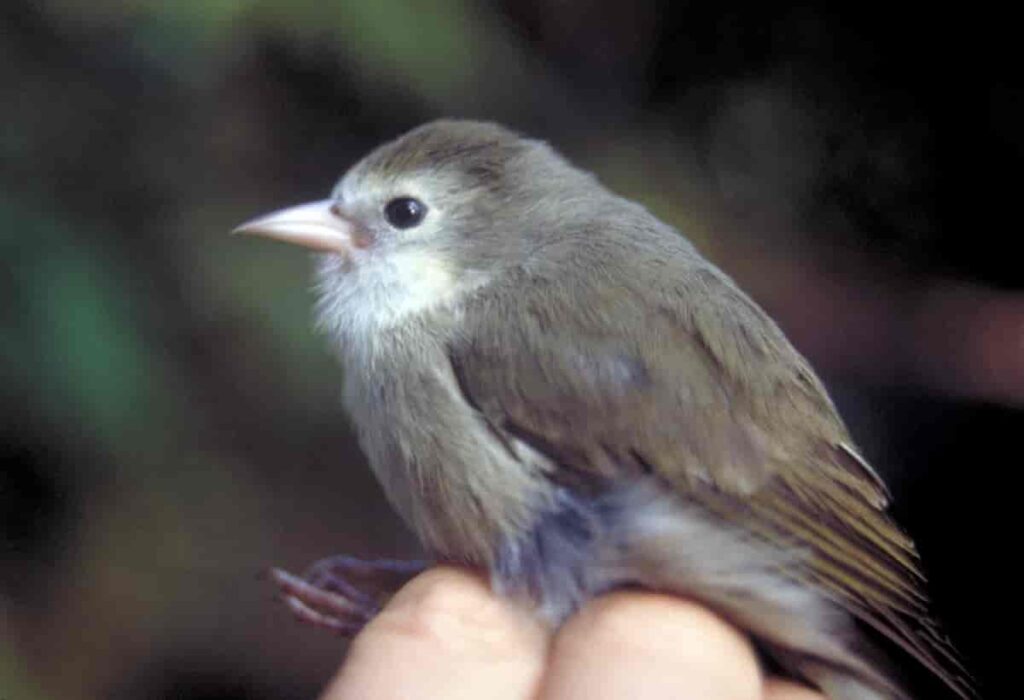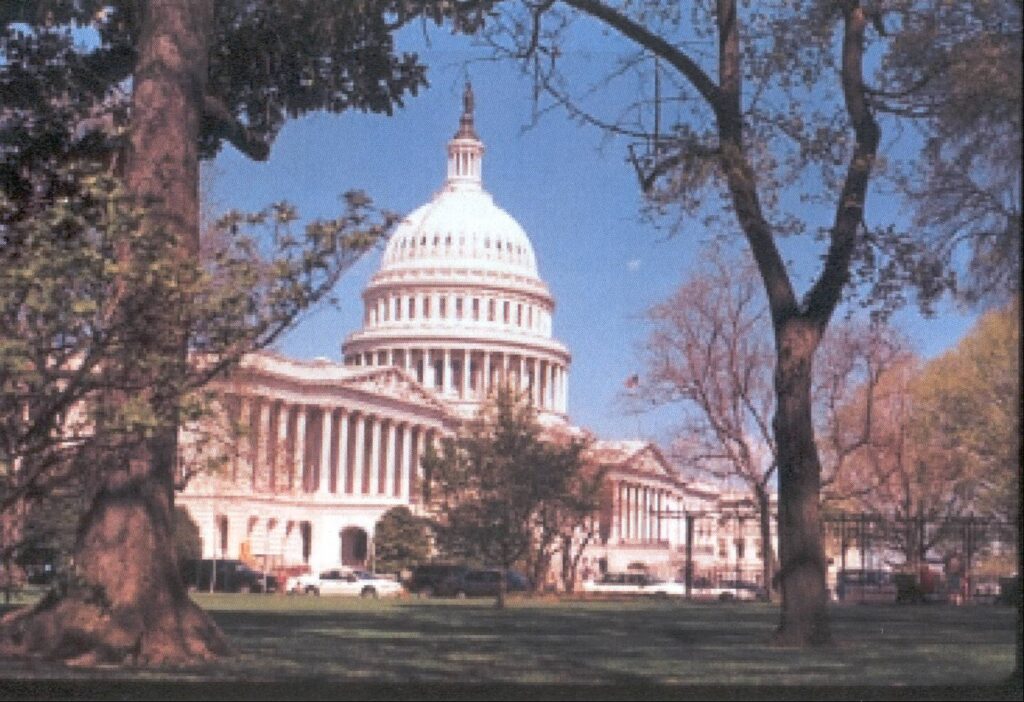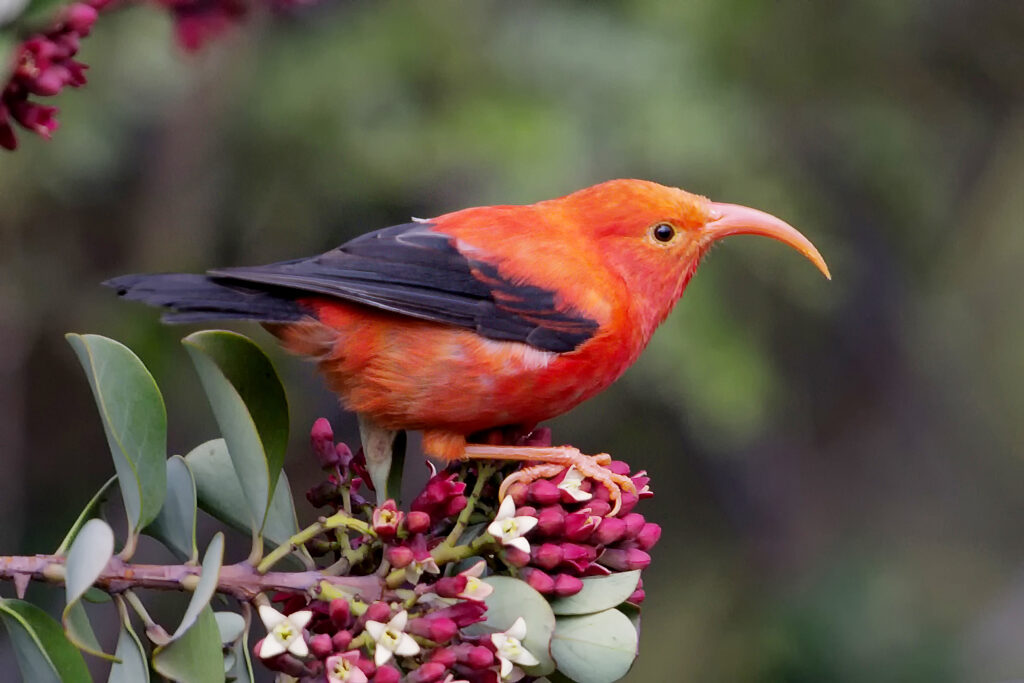‘i‘iwi (Drepanis coccinea) – formerly very common from low to high elevations; photo by James Petruzzii_U
The endangered honeycreepers (birds) of Hawaiian forests are receiving the attention they deserve – and desperately need. There is good news! Promising and significant efforts are under way, matched to a recent strategic plan. However, it is too early to know their results.
Nearly two and a half years ago, I blogged about efforts by a multi-agency consortium (“Birds, Not Mosquitoes” ). It was working to suppress populations of non-native mosquitoes, which vector two lethal diseases: avian malaria (Plasmodium relictum) and avian pox virus (Avipoxvirus). A single bite from an infected mosquito is enough to weaken and kill birds of some species, e.g., the ‘i‘iwi.
The threats from these diseases – and their spread to higher elevations as mosquitoes respond to climate change – pile on top of – other forms of habitat loss and inroads by other invasive species. All of the 17 species of honeycreeper that have persisted until now are listed as endangered or threatened under the federal Endangered Species Act. Four are in danger of extinction within as little as 1 – 2 years. These are ‘Akeke`e (Loxops caeruleirostris), ‘Akikiki (Oreomsytis bairdi)), Kiwikiu (Maui parrotbill, (Pseudonestor xanthophrys), and `Akohekohe (Palmeria dolei).

All these bird species are endemic to the Hawaiian archipelago — found nowhere else on Earth. They are already remnants. Nearly 80 bird species have gone extinct since people first colonized the Hawaiian Islands 1,500 years ago. Eight of these extinctions were recognized in October 2021. Extinction of the final cohort would compromise the integrity of unique ecosystems as well as the Islands’ natural and cultural heritage.
I rejoice to report that the federal government has responded to the crisis. In late 2022 several Interior Department agencies adopted a multiagency Strategy for Preventing the Extinction of Hawaiian Forest Birds. The strategy specifies responsibilities for the key components of the program. These include: a) planning and implementing landscape-level mosquito control using Incompatible Insect Technique (IIT); b) translocating birds to higher elevation sites on other Hawaiian islands; c) establishing captive populations of at-risk birds; and d) developing next-generation tools that increase the scope or efficacy of these actions. All these activities are being developed and conducted through intensive consultation with Native Hawaiians.
On August 8, 2023, the Secretary of Interior announced the allocation of $15,511,066 for conservation and recovery efforts for Hawaiian forest birds. About $14 million of the total was from the Bipartisan Infrastructure Law (Public Law 117-58). The funds are being channelled primarily through the U.S. Fish and Wildlife Service (FWS) ($7.5 million) and the National Park Service (NPS) ($6 million). Other sources of funding are the “State of the Birds” Program (FWS – $963,786); the national-level competitive Natural Resource grants program (NPS – $450,000); and the Biological Threats Program of the U.S. Geological Survey (USGS – $100,000).
What Is Under Way
I do worry continuing these efforts will be harder once their funding is subject to annual appropriations. However, they are a good start!
Steps have been taken on each of the four key component of the Strategy for Preventing the Extinction of Hawaiian Forest Birds:
a) Planning and implementing landscape-level mosquito control using Incompatible Insect Technique (IIT – see below) to reduce the mosquito vector of avian malaria.
- The Consortium has obtained all necessary state permits, regulatory approval of the approach by the U.S. Environmental Protection Agency, and done required consultations under the Endangered Species Act.
- The Department of the Interior has funded a public-private partnership between the National parks and The Nature Conservancy (TNC) to develop, test, and carry out the first deployments of IIT. These occurred in May 2023 at high-elevation sites on the island of Maui. The next releases are planned for Kaua`i.
- Consortium participants are carrying out the consultations and scientific preparations need to support the next deployment on the Big Island.
b) Translocating birds to higher elevation sites on the one island where they exist – Hawai`i.
- Initial planning has begun to guide translocation of the endangered Kiwikiu (Maui parrotbill) and Akohekohe to higher-elevation, mosquito-free, habitats on the Big Island.
c) Establishing captive populations of the most at-risk species
- To facilitate captive breeding of the four most endangered species, the two existing aviaries in Hawai`i need to be expanded. Space must be provided for at least 80 more birds. A contract has been signed for construction of this new aviary space.
d) Developing next-generation tools that increase the scope or efficacy of these actions.
- Lab capacity has been expanded to monitor the effectiveness of IIT, as well as for developing next-generation mosquito control tools.

The Incompatible Insect Technique (IIT) explained
The incompatible insect technique has been used successfully elsewhere to combat mosquitoes that transmit human diseases. Many insect taxa – including mosquitoes – harbor a naturally-occurring bacteria (Wolbachia). This bacterium has more than one strain or type. When a male mosquito with one type of Wolbachia mates with a female mosquito bearing a different, incompatible type, resulting eggs do not hatch. The IIT project releases male mosquitoes that have an incompatible strain of the bacterium than do local females. (Male mosquitoes do not bite animals seeking a blood meal, so releasing them does not increase the threat to either birds or people.) Implementation requires repeat treatment of sites at a cost of more than $1 million per site per year. It is hoped that this cost will fall with more experience.
Funding for the Strategy’s Four Components
As I noted above, much of the funding for these efforts has come from the Bipartisan Infrastructure Law (Public Law 117-58). Grants under this one-time statute are intended to cover project costs for perhaps five years. Other sources of funds are Congressional appropriations to Interior Department agencies under programs which presumably will continue to be funded in future years. These include the “State of the Birds” program; Endangered Species Act (ESA) implementation, especially its §6 Cooperative Endangered Species Conservation Fund; and State Wildlife Grants administered by the U.S. Fish and wildlife Service. However, funding under these programs is never guaranteed and competition is fierce. I hope participants – and the rest of us! – can be effective in lobbying for future funds required to save Hawaii’s birds from extinction.
a) Deploying IIT
Over Fiscal Years 2017 – 2021 (ending September 2021), Interior Department agencies supported the IIT program by:
- Providing $948,000 to the State of Hawai`i from “State of the Birds”, State Wildlife Grants, and Endangered Species Act (ESA) §6;
- The U.S. Fish and Wildlife Service provided $545,000 plus staff time’
- National Park Service provided $1.2 million for IIT preparations at Haleakala National Park and surrounding state and Nature Conservancy lands
- U.S. Geological Survey provided about $7.05 million in research on Hawaiian forest birds, invasive mosquitoes, and avian malaria.
The State of Hawai’i allocated $503,000 and employee staff time.
In addition,
- the National Fish and Wildlife Fund provided a total of $627,000 in grants to TNC and American Bird Conservancy for Wolbachia IIT.
- TNC committed to supporting some of the initial costs to deploy Wolbachia IIT for the first site in Hawai`i through a contractor (see below)
- American Bird Conservancy provided funding for coordination and public outreach.
In FY2022 (which ended in September 2022),
- NPS provided $6 million for on-the-ground work on Maui, also development and initial production of Wolbachia IIT.
- Interior Department Office of Native Hawaiian Relations provided in-kind services to engage with Native communities’ members
b) Moving endangered birds to mosquito-free areas at high elevations on the Big Island
This is planned to begin by 2030. Interior committed unspecified funds to planning and consultation with Native Hawaiians.
c) Rearing captive birds
FWS supports operation of the two existing aviaries through two funding channels: $700,000 annually provided directly to the aviaries, plus another $500,000 per year through ESA §6through the State of Hawai`i. The San Diego Zoo – which operates the aviaries — provides $600,000 – $800,000 per year in the form of in-kind services, staffing, veterinarians, and administrative support. Interior’s Office of Native Hawaiian Relations provided in-kind services to support to engagement with Native Hawaiian community members
d) Regarding exploration of “next-generation” mosquito control tools
The FWS provided $60,000 to a scientific laboratory to study precision-guided Sterile Insect Technique (pgSIT) tools to protect bird species threatened by avian malaria.
Funding for the portions of these programs dependent upon annual appropriations is uncertain. Current signs are promising: House and Senate bills to fund for the current year (Fiscal Year 2024) – which began in October 2023! – both support at least some aspects of the program. According to American Bird Conservancy, the Senate appropriations bill has allocated $2.5 million to parts of the program. According to the Committee report, the House appropriations bill allots $4.7 million to the State of the Birds program to respond to urgent needs of critically endangered birds. The report goes on to direct the FWS to “incorporate adaptation actions into new and revised recovery plans and recovery implementation strategies, such as with the mosquito vector of avian pox & malaria in the revised Hawaiian Forest Birds recovery plan. …” Per the report, the Appropriations Committee “continues to encourage the [NPS] to respond to the urgent landscape-scale needs of critically endangered forest birds with habitats in national parks.” The report then specifies species threatened by non-native mosquitoes carrying avian malaria and other pathogens. Finally, the report allocates $500,000 to the U.S. Geological Survey for research on the Hawaiian forest birds.
Meanwhile, the American Bird Conservancy is preparing to advocate for $20 million for FY25 through “State of the Birds” Activities and associated NPS and USGS programs. The details of this amount have not yet been laid out.
CISP will support this request and urges you to do so also. We will suggests ways to help when we know more.
Posted by Faith Campbell
We welcome comments that supplement or correct factual information, suggest new approaches, or promote thoughtful consideration. We post comments that disagree with us — but not those we judge to be not civil or inflammatory.
For a detailed discussion of the policies and practices that have allowed these pests to enter and spread – and that do not promote effective restoration strategies – review the Fading Forests report at http://treeimprovement.utk.edu/FadingForests.htm
or
